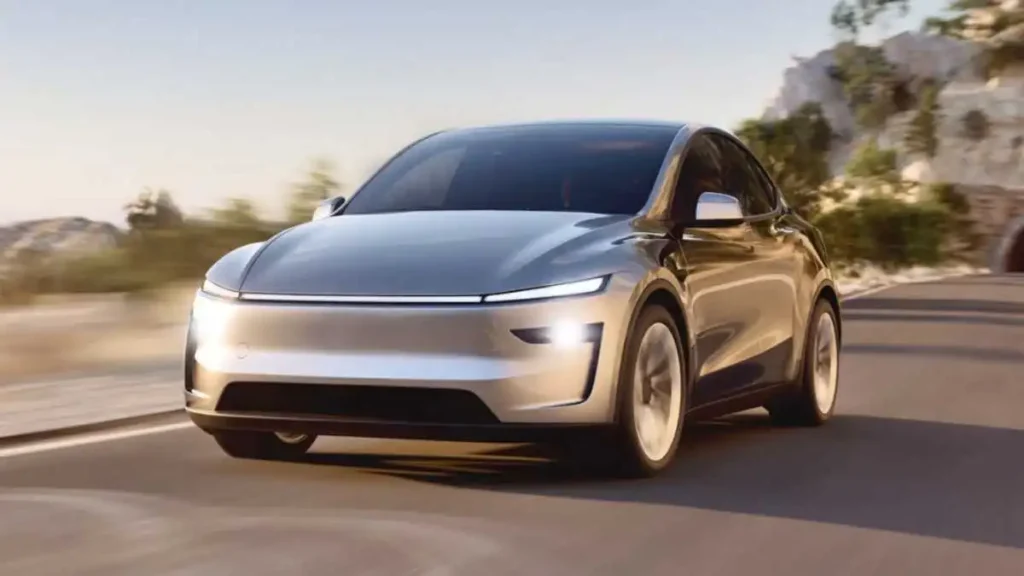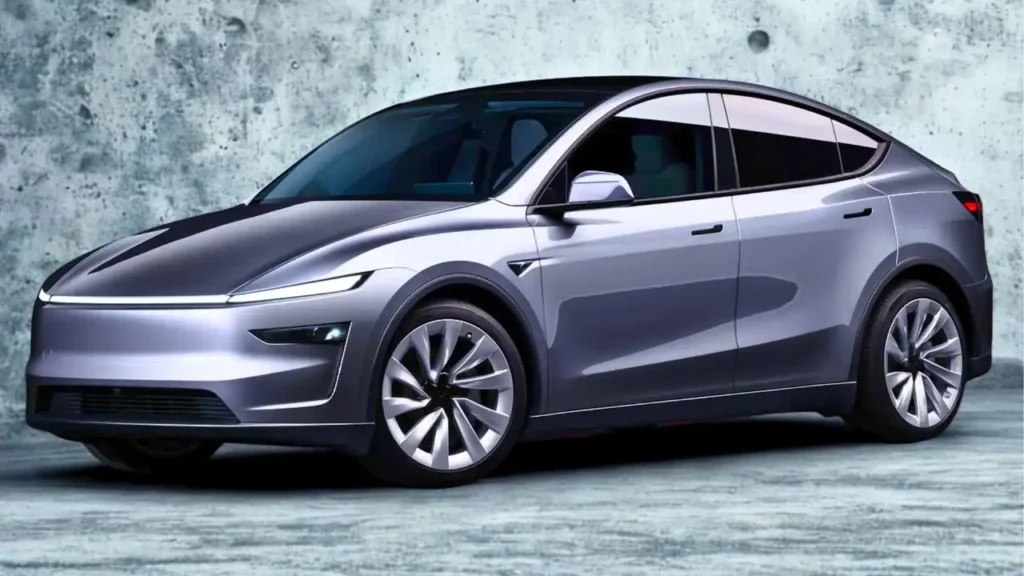Business
Elon Musk Finally Reveals Tesla’s Cheaper EV And It’s Not What You Think…
Forget the Model 2—Musk says Tesla’s affordable EV is “just a Model Y,” as the company quietly begins production to combat slumping sales and fading tax credits

After months of mystery and speculation, Elon Musk has finally pulled the curtain back on Tesla’s much-hyped cheaper electric vehicle. And in a surprising twist, it’s not a new car at all.
“It’s just a Model Y,” Musk said flatly during Tesla’s Q2 earnings call this week. “Let the cat out of the bag there.”

That “cat” was expected to be Tesla’s long-rumored “Model 2”, a $25,000 compact EV that would disrupt the market and open up a new chapter in affordable electric mobility. Instead, Musk confirmed the upcoming vehicle is simply a more affordable version of the existing Model Y — the company’s global best-seller.
So, What Exactly Is Tesla’s “Cheaper EV”?
Tesla began initial production of the cheaper Model Y variant in June 2025, with mass production expected in the second half of the year, according to the company’s earnings release.
The new variant is not a revolutionary redesign, but rather a cost-reduced trim of the same Model Y we already know. It’s expected to feature cheaper materials, potentially a smaller battery, and scaled-back interiors — think cloth seats, fewer software features, and no frills.
“The desire to buy the car is very high. Just people don’t have enough money in their bank account,” Musk said. “So the more affordable we can make the car, the better.”
Tesla’s Lars Moravy, Vice President of Engineering, said that volume production won’t ramp up meaningfully until late Q4, noting the company will keep pushing current models to avoid complexity during Q3 — especially as the $7,500 EV tax credit is set to expire after September 30.
Table of Contents
How Much Cheaper Will It Be?
Right now, the base Model Y starts at $44,990 (before incentives). Industry watchers believe the cheaper variant could land closer to $35,000, making it one of Tesla’s most accessible vehicles to date.
That price point could allow Tesla to unlock an entirely new customer base—but whether it will be enough to reignite growth remains to be seen.

Why Tesla Needs This EV Now More Than Ever
Tesla’s recent performance shows a clear loss of momentum. The company has struggled with:
- Declining deliveries of core models like the Model 3 and Model Y
- Underwhelming performance of its Cybertruck, with sales dropping 50% to just 4,300 units last quarter
- Slowing EV demand growth in the U.S. and abroad
- The looming expiration of the federal EV tax credit
Unlike competitors like Toyota, Volkswagen, or General Motors—who offer broad vehicle lineups across multiple price points—Tesla remains highly dependent on two models: the Model 3 and Model Y.
Without a compelling, lower-cost offering, Tesla risks being boxed out of a price-sensitive market that is now crowded with well-equipped alternatives from BYD, Hyundai, and even Ford.

Will This “Cheaper” Model Y Be Enough?
Musk’s confirmation squashes hopes for a groundbreaking new Tesla hatchback or a uniquely small, urban EV. While it may disappoint fans expecting innovation, it may prove a smart, pragmatic strategy to optimize existing production lines without incurring massive R&D or manufacturing costs.
Tesla has done this before — launching a stripped-down Model 3 variant in Mexico and a Model Y L with a third row in China earlier this year. This upcoming Model Y variant, rumored internally as Project E41, appears to be a continuation of that strategy.
Still, analysts remain cautious. A cheaper car might boost short-term sales, but can it solve Tesla’s bigger problems—from global competition to political controversy surrounding its CEO?
The Bottom Line
Tesla’s cheaper EV is not a new Tesla, it’s just a more accessible Model Y. And while that may seem underwhelming, it could be just what the company needs to survive a turbulent phase in the EV industry.
The question is, will this move help Tesla reclaim its dominance — or is it simply a temporary patch on deeper structural issues?
For more Update http://www.dailyglobaldiary.com
Business
Tesla’s record sales boost Elon Musk past $500 billion… but will the momentum last?
A record-breaking third quarter lifted Tesla’s sales and briefly made Elon Musk the world’s first half-trillionaire, but growing competition and policy changes raise tough questions ahead.

For Tesla and its high-profile CEO Elon Musk, the third quarter of 2025 delivered both a record and a warning. The electric vehicle giant sold 497,099 cars worldwide from July through September, the highest quarterly tally in its history. That surge briefly pushed Musk’s fortune above $500 billion, according to Forbes’ billionaire tracker, making him the first person to ever cross that threshold.
But just as quickly as Tesla stock spiked, the gains began to slip. By Thursday afternoon, Tesla’s shares had dropped nearly 4%, pulling Musk’s net worth back down to $490 billion.
The tax credit rush
The record quarter was driven by a last-minute rush from American buyers before a $7,500 federal EV tax credit expired on September 30. The incentive, introduced under the Biden administration in 2022, was eliminated as part of Donald Trump’s sweeping spending and tax bill earlier this year.
That policy change sparked a short-term boom — but experts warn it could lead to a slump in coming months. Despite the blockbuster quarter, Tesla’s overall year-to-date sales remain 6% lower compared to 2024.

Rivals close in
Tesla wasn’t the only automaker enjoying the tax-credit frenzy. General Motors more than doubled its US EV sales in the same quarter, while Ford reported a 30% jump. Hyundai also doubled its US EV sales, even as it cut prices on its IONIQ 5 by more than $9,000 to stay competitive.
And outside America, Tesla’s biggest threat may come from BYD. The Chinese automaker reported a 31% year-over-year surge in sales, bringing its total EV passenger cars sold in 2025 to 1.6 million, compared to Tesla’s 1.2 million. Despite not selling in the US, BYD is now on track to overtake Tesla as the world’s largest EV maker.
Market share pressures
Tesla’s dominance is no longer assured. Registration data shows the company continues to lose global market share to rivals. While loyal fans still associate Tesla with innovation, some buyers have been turned off by Musk’s outspoken political activity, which has triggered protests in both the US and Europe.
Meanwhile, Chinese automakers like BYD are capturing more of the European EV market, eroding Tesla’s stronghold. And with automakers such as GM, Ford, and Hyundai slashing prices, Tesla faces the pressure of a rapidly commoditizing EV industry.

What’s next?
The third quarter record may end up being a fleeting high point. Analysts say Tesla’s next big challenge will be proving it can sustain growth without the tailwind of government subsidies and while fighting intensifying competition across every major market.
For more Update http://www.dailyglobaldiary.com
Business
UK drivers brace for major tax shake-up as weight-based charges could hit petrol, diesel and EVs alike…
A leading think tank proposes replacing emissions-based road tax with a pay-per-mile system tied to vehicle weight—potentially raising costs for heavy SUVs and electric cars.

British drivers may soon face a radical shift in road taxation, with proposals suggesting that car owners will be charged based on vehicle weight rather than emissions. The plan, set out by the influential Resolution Foundation, could affect millions of motorists—whether they drive petrol, diesel, or electric cars.
Why change the system?
Currently, the UK’s Vehicle Excise Duty (VED) is largely calculated on tailpipe emissions. This means electric vehicles (EVs), which produce zero CO₂ on the road, have often avoided paying road tax altogether. But as EV adoption accelerates, the Treasury is losing billions in revenue once generated from combustion cars.
With EVs projected to dominate new sales in the next decade, policymakers are under pressure to find a sustainable replacement.
The weight-based proposal
The Resolution Foundation suggests a “pay-per-mile” system that scales with a car’s weight. Under the model:

A lightweight EV weighing 1,000kg would pay about 3p per mile.- A mid-sized EV weighing 1,800kg would pay 6p per mile.
- A large SUV or heavy EV above 2,800kg could face up to 9p per mile.
The idea is to link road charges directly to the impact cars have on infrastructure and the environment—heavier vehicles cause more road wear, produce greater tyre and brake pollution, and pose higher risks to pedestrians.
Not just EVs
Importantly, the proposed system would not single out EVs. Traditional petrol and diesel vehicles could also see their flat £195 VED replaced with weight-tiered charges, making it a universal system for all drivers.
Global precedents
Weight-based taxation is not a new idea. Countries like the Netherlands, Estonia, and even New South Wales, Australia, already have similar frameworks in place. Advocates say these systems have improved fairness while discouraging oversized cars.
Government response
The UK Treasury has already signaled its intent to reform motoring taxes, introducing VED for EVs in 2025 and investing over £2 billion to boost greener transport. A spokesperson said policymakers are balancing the need for revenue with incentives for low-emission travel.
Industry experts believe the changes could reshape car-buying behavior. Families may think twice before purchasing bulky SUVs, while manufacturers could feel pressure to design lighter, more efficient EVs.

A fundamental shift
For drivers, the impact could be significant. Someone covering 10,000 miles annually in a heavy EV could face £900 in extra charges. For large SUV owners, this could be even higher.
Critics argue the timing is delicate—just as the UK is trying to encourage EV adoption, heavier taxes may discourage buyers. Supporters counter that fairness and sustainability should guide future policy.
Either way, the shift from emissions-based to weight-based taxation would mark one of the most dramatic changes in UK road policy in decades—and every driver will feel it.
For more Update http://www.dailyglobaldiary.com
Business
Ford CEO Jim Farley warns EV sales could plunge by 50% as $7,500 tax credit ends…
The end of federal incentives may slash U.S. electric vehicle sales in half, forcing Ford and rivals to rethink their EV strategies.

Ford Motor Company CEO Jim Farley has delivered one of the starkest warnings yet for the U.S. electric vehicle (EV) market, saying demand could collapse by nearly 50% once federal tax incentives disappear.
Speaking at Ford’s “Pro Accelerate” event in Detroit on Tuesday, Farley said EV sales, which are currently hovering around a record 10–12% of the U.S. auto market, could sink to just 5% starting next month.
“We’re going to find out in a month. I wouldn’t be surprised if EV sales in the U.S. go down to 5%,” Farley said.
The policy shift
The forecast comes as the $7,500 federal EV incentive ends under the Trump administration’s “One Big Beautiful Bill Act.” The legislation removed blanket EV subsidies but added perks for vehicles assembled in the U.S., regardless of whether they are electric or combustion-based.
The policy change is already altering consumer behavior. Cox Automotive projects EV sales hit a record 410,000 units in Q3 2025, a 21% jump year-on-year, as buyers rushed to take advantage of the expiring credit. But analysts expect demand to slump once the incentive is gone, with many buyers effectively “pulling forward” their purchases.

Expensive cars, cautious buyers
Farley was blunt about the challenge facing automakers:
“Customers are not interested in the $75,000 electric vehicle. They find them interesting. They’re fast, they’re efficient, you don’t go to the gas station, but they’re expensive.”
Ford currently sells models like the F-150 Lightning, which can top $90,000, and the Mustang Mach-E, a crossover positioned against rivals from Tesla and Hyundai. But Farley noted that customers seem more comfortable with hybrids and “partial electrification” for now, calling them “easier for customers to accept.”
Industry-wide ripple effects
The uncertainty could have major consequences for automakers’ massive EV investments. Ford has spent billions on EV development and battery plants across the U.S., but Farley acknowledged those facilities may now face “more stress.”
“We’ll fill them, but it will be more stress, because we had a four-year predictable policy. Now the policy changed. We all have to make adjustments,” he said.
The broader industry is watching closely. Tesla, General Motors, and Hyundai have all banked on rapid EV adoption to justify their expansion plans. The sudden shift could force a rethink in pricing, production, and supply chain strategies.

Skilled trades and the “essential economy”
Farley’s comments came during a Ford-hosted discussion on skilled labor and education. The event drew executives and public officials who emphasized the need for training workers to support both traditional auto manufacturing and the emerging EV ecosystem.
While Farley expressed optimism that EVs will remain “a vibrant industry,” he admitted it will be “way smaller than we thought,” at least in the near term. For automakers, the message is clear: the road to electrification just got a lot bumpier.
For more Update http://www.dailyglobaldiary.com
-

 Entertainment1 week ago
Entertainment1 week agoDolly Parton delays Las Vegas concerts by nine months citing health challenges but promises unforgettable return
-

 Entertainment1 week ago
Entertainment1 week agoZoey Deutch engaged to comedian Jimmy Tatro after 4 years of dating with romantic beach proposal
-

 Entertainment4 days ago
Entertainment4 days agoSurvivor Season 49 episode 2 shocker Kele tribe loses again and fans stunned by who went home
-

 Sports3 days ago
Sports3 days ago‘Silent killer’ Cam Schlittler stuns Red Sox as Yankees rookie makes history with 12 strikeouts
-

 Politics1 week ago
Politics1 week agoBarack Obama blasts Trump over Tylenol autism claim calling it ‘violence against truth’ but that’s not all he said…
-

 Sports5 days ago
Sports5 days agoTottenham’s Champions League wake-up call… why Spurs must stop looking like a Europa League side
-

 Entertainment2 days ago
Entertainment2 days agoCharlie Hunnam reveals chilling transformation into serial killer Ed Gein for Ryan Murphy’s Monster… “I didn’t want to glamorize it”
-

 Crime & Justice5 days ago
Crime & Justice5 days agoProsecutors demand 11 years for Diddy after shocking trial says Cassie’s testimony revealed dark truth




























